Expert’s Rating
Pros
- Incredible cameras
- Flawless performance
- Super-fast charging
- Stunning screen
Cons
- HyperOS software annoyances
- Fingerprint magnet on certain colours
- More expensive than some rivals
Our Verdict
The Xiaomi 14 is a brilliantly competent and compact flagship for 2024 with gorgeous design, top-notch hardware and powerful performance. The question is whether you’re happy to pay more than key rivals while putting up with HyperOS.
Price When Reviewed
Unavailable in the US
Xiaomi’s flagship range of smartphones for 2024 is here and although we don’t get the Pro, the regular Xiaomi 14 and 14 Ultra make for a formidable duo.
It’s the regular on test here, which might not be as headline-grabbing as the Ultra, but a brilliant smartphone in just about every respect.
It comes in at £849 in the UK and has all the things we want to see in a recommendable flagship, including a top-notch display (and a compact one at that), excellent cameras co-developed with Leica, smooth performance, speedy charging and more.
The phone is worthy – which I thought it might after just 24 hours – of a very high score but let’s delve deeper to find out.
Find out what handsets rank in our round-up of the best smartphones.
Design & Build
- Compact and stylish
- IP68
- Three colours
I have very little to complain about when it comes to the design and build of the Xiaomi 14. It’s a proper little stunner and it doesn’t bother me that the look and feel hasn’t change much compared to the Xiaomi 13.
It’s not a compact phone like the iPhone minis and Sony Xperia Compacts of yesteryear, but it’s certainly one of the most pocket-friendly flagships of 2024.
The premium design looks every bit the part, from the tiny bezel around the screen to the luxury watch-esque texturing around the camera module.
I’m not super keen on the shiny chrome effect of the frame but the rear cover of my Jade Green sample is unusual and gorgeous.
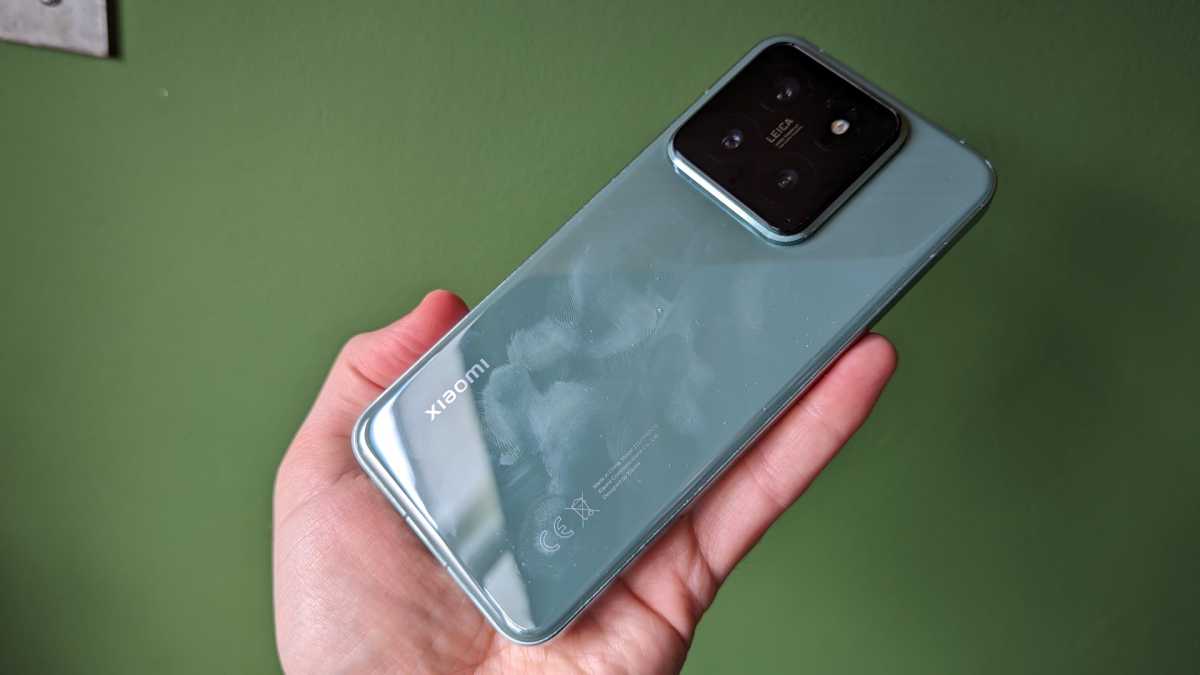
Chris Martin / Foundry
It does, however, have two problems. The first is that it sounds a little hollow if you give it a tap in the middle, but much worse is how easily it attracts fingerprints and other grubby marks.
The glossy finish of this 3D curved glass back only looks great for the first 30 seconds out of its box. Xiaomi does provide a decent dark grey silicone case but it’s a shame to cover up the nice green.
The premium design looks every bit the part, from the tiny bezel around the screen to the luxury watch-esque texturing around the camera module
From the looks of it the white colourway is similarly shiny but the black option has a matt finish, so it might be your best bet.
It’s a shame as the phone feels very solid and durable so I’d be happy using it without a case for the most part. The Gorilla Glass Victus front comes with a screen protector applied and the phone is IP68 rated so fully dust and water resistant, as a flagship should be.
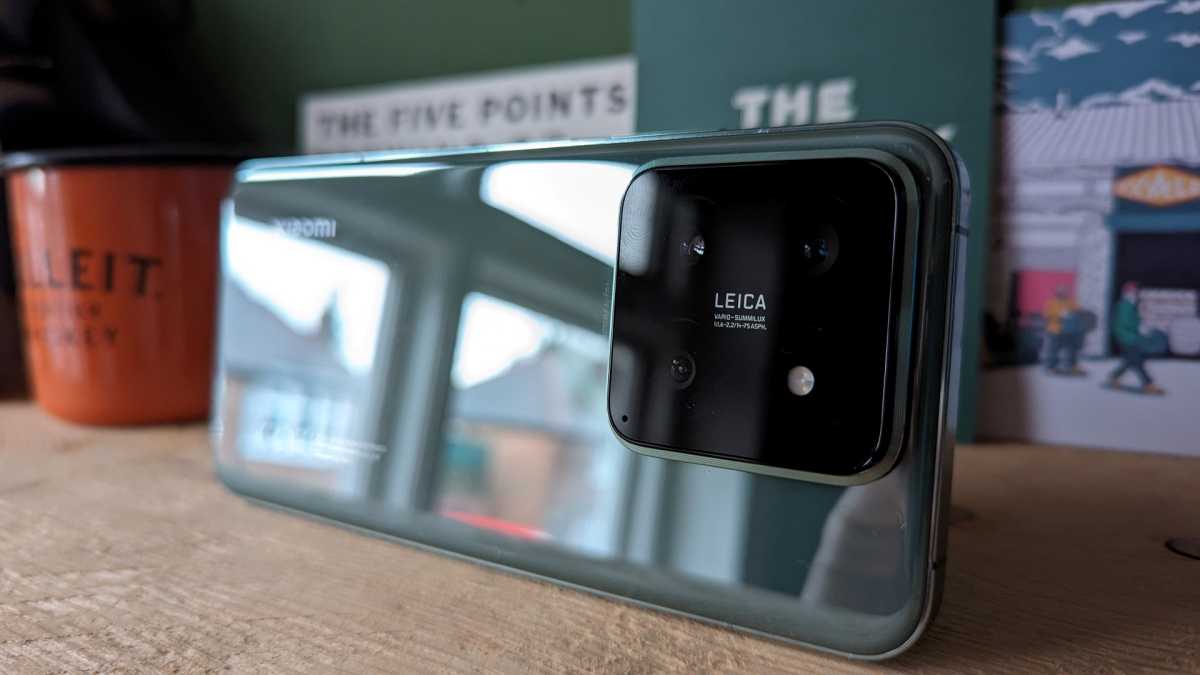
Chris Martin / Foundry
The issues here are common in the smartphone world so it’s not like getting a rival is going to be hugely different, I just crave a phone that isn’t a slippery fingerprint magnet and not in a boring colour.
The key factor here in the wider market is that the Xiaomi 14 is one of the most compact and easy to handle flagships you can get. It’s 8.2mm thick and 193g, which is similar to the Pixel 8.
Haptic feedback is generally good, though the way it responds isn’t my favourite. It’s mostly quick and sharp but can get a little buzzy at times, to the extent that it becomes audible. However, you can easily adjust the vibration level in Settings.
Screen & Speakers
- 6.36-inch AMOLED
- 1-120Hz
- Stereo speakers
At 6.36-inch and using AMOLED technology, the display might sound like the same as its predecessor, but it gets a few upgrades that make for a nice step up.
The slightly higher Full HD+ (2670 x 1200) resolution is welcome but it’s the addition of LTPO panel tech that’s more important here. It means the refresh rate can scale from 120- down to 1Hz to save battery when a higher rate is simply not needed.
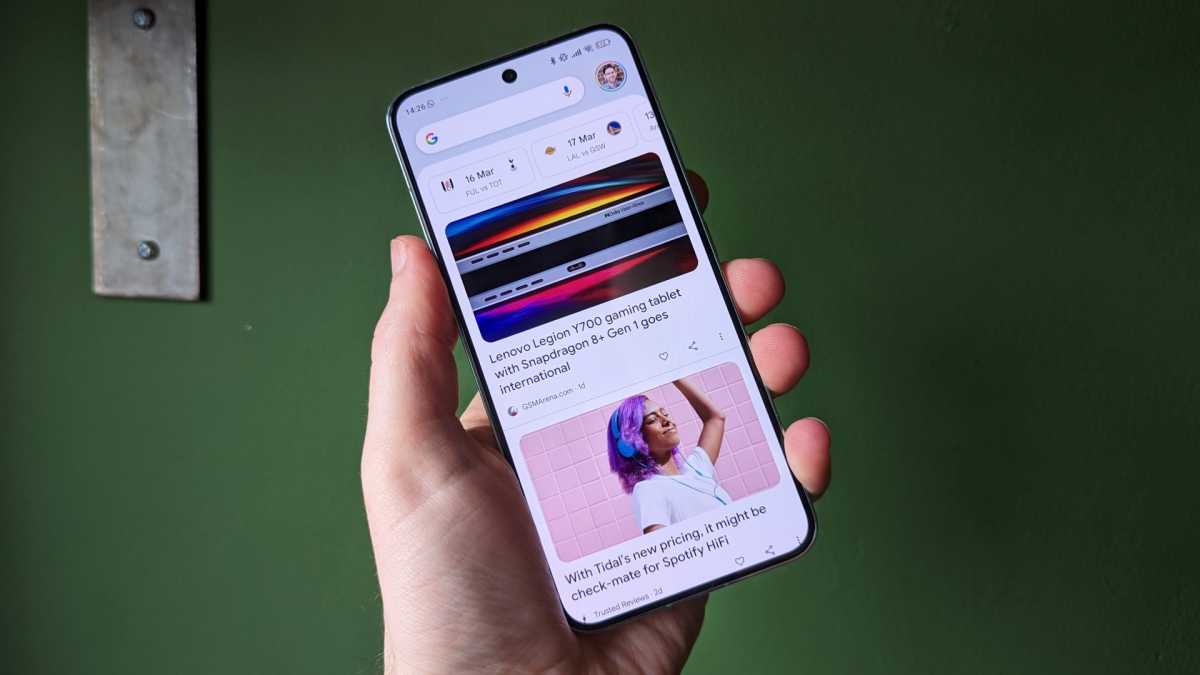
Chris Martin / Foundry
It also gets a brightness boost to a theoretical peak of 3000 nits. I measured it with auto-brightness switched off at a decent 702 nits and had no problems using it in any situation.
Along with the aforementioned slither of a bezel and features such as a touch 240Hz sampling rate and support for HDR10+ and Dolby Vision, the Xiaomi 14’s display is gorgeous – there’s nothing I can complain about.
The Xiaomi 14’s display is gorgeous – there’s nothing I can complain about
The under-display optical fingerprint scanner works very well with a high level of accuracy. It’s just perhaps slightly low down in terms of placement for me but only by a little.
Although there’s no 3.5mm headphone jack, that’s not a surprise for a 2024 flagship phone.
Meanwhile, the stereo speakers on offer here are decent with plenty of volume available. The mid-range is rich and high end crisp, while the lack of bass is very common on phones.
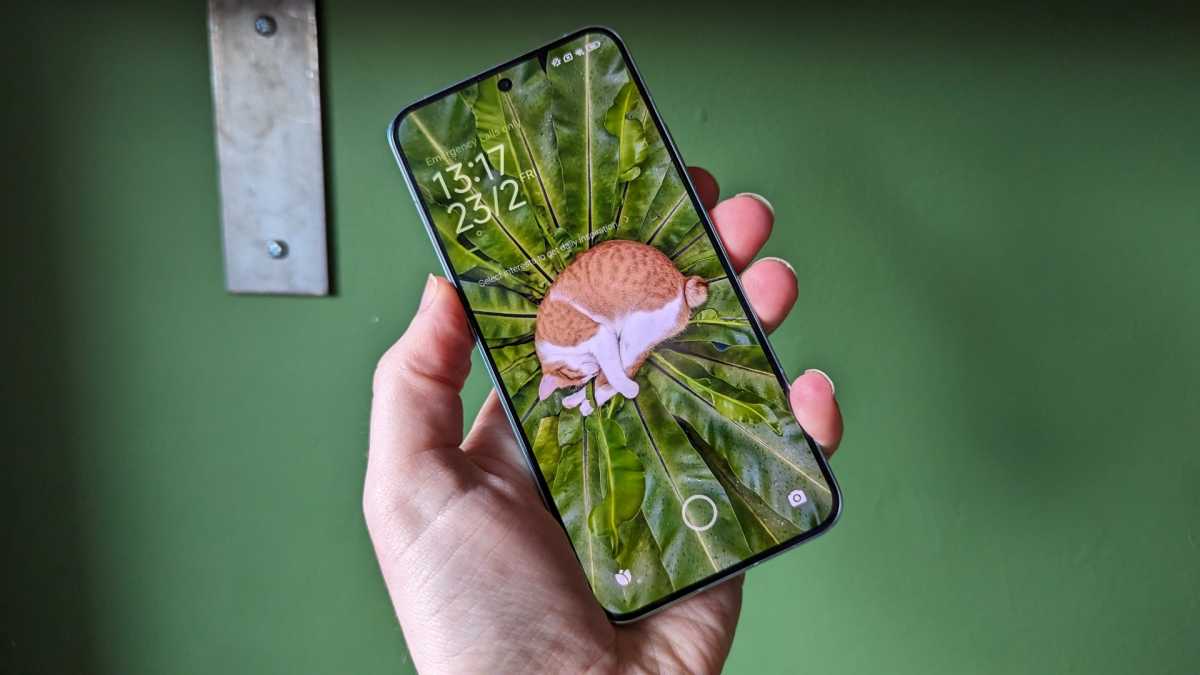
Chris Martin / Foundry
Specs & Performance
- Snapdragon 8 Gen 3
- 12GB RAM
- 256/512GB storage
I have absolutely no quibbles with performance on this phone. I didn’t expect to, but can confirm: when it comes to performance, the Xiaomi 14 is a pocket rocket.
The Qualcomm Snapdragon 8 Gen 3 might not be overclocked like the ‘for Galaxy’ version found in Samsung’s S24 range but it’s plenty fast enough to satisfy power users.
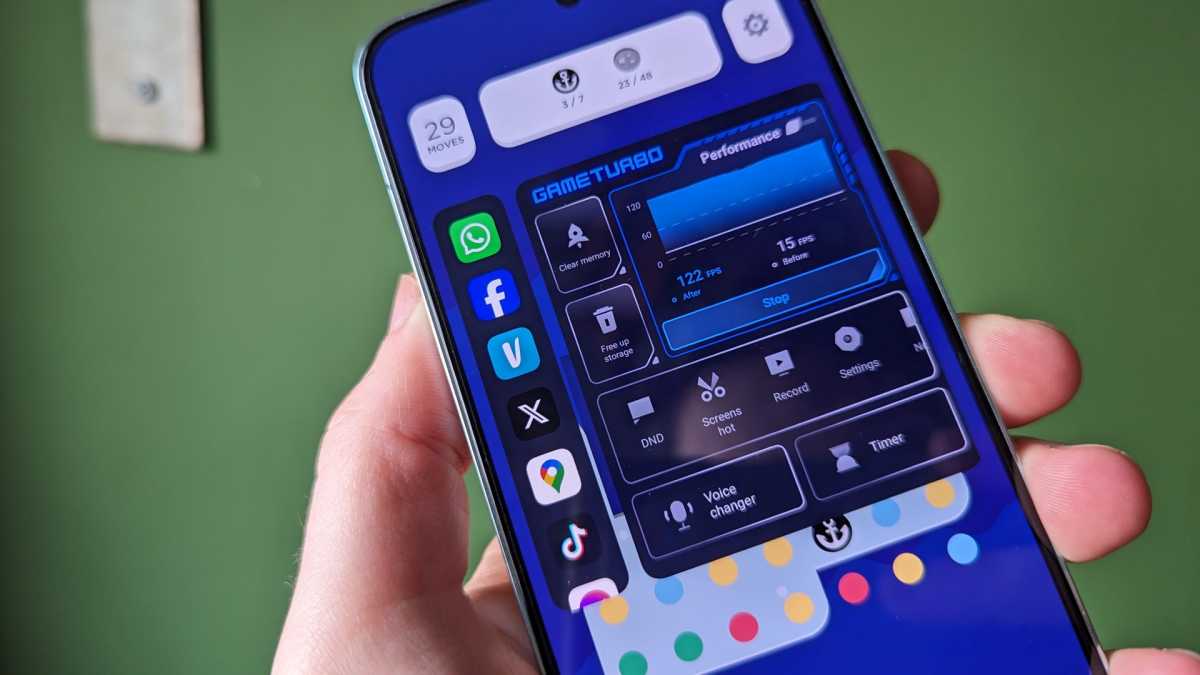
Chris Martin / Foundry
The chip is paired with a very healthy 12GB of RAM, regardless of whether you choose to get 256- or 512GB of internal storage. Think about that wisely as there’s no microSD card slot here and with only £50 extra to double the storage, that could be a real boon down the line.
Processor, RAM and storage are all an improvement on the Xiaomi 13 for the same price which is a rare thing to see.
When it comes to performance, the Xiaomi 14 is a pocket rocket
Everything happens with lightning speed on the Xiaomi 14, from navigation to loading apps. Double tapping the recent apps button to switch to your last used app happens in a flash.
It can handle gaming very well indeed, with the ability to play the most demanding games such as Genshin Impact at the highest settings without dropping frames or any kind of noticeable lag.
The phone will get warm towards the top after an extended period of gaming, but never enough to worry about. Xiaomi’s ‘IceLoop’ cooling system seems to do the job well.
Xiaomi 14 benchmarks
In terms of other core specs, you couldn’t really ask for more from the Xiaomi 14. It has both Bluetooth 5.4 (with AptX Adaptive/LDAC/LHDC 5.0 support) and Wi-Fi 7 (with Qualcomm FastConnect 7800 Mobile Connectivity System) support – these are the very latest standards at the time of writing.
There’s also GPS, NFC, an IR blaster (yes that’s very useful for controlling the TV when your one-year-old has hidden the remote), 5G and dual-SIM with support for two nano SIMs or one physical and one eSIM.
Cameras & Video
- Triple 50Mp rear cameras with Leica
- 32Mp selfie cam
- DSLR-level results
Photography is an area where the Xiaomi 14 has received a significant upgrade over its predecessor.
A trio of 50Mp rear facing cameras (co-developed with iconic camera company Leica) makes for a formidable setup. The Xiaomi 13 had one 50Mp shooter but 12- and 10Mp ultrawide and telephoto options alongside it respectively.
After significant testing, the Xiaomi 14 comes out as one of the best camera phones that we’ve ever tested.
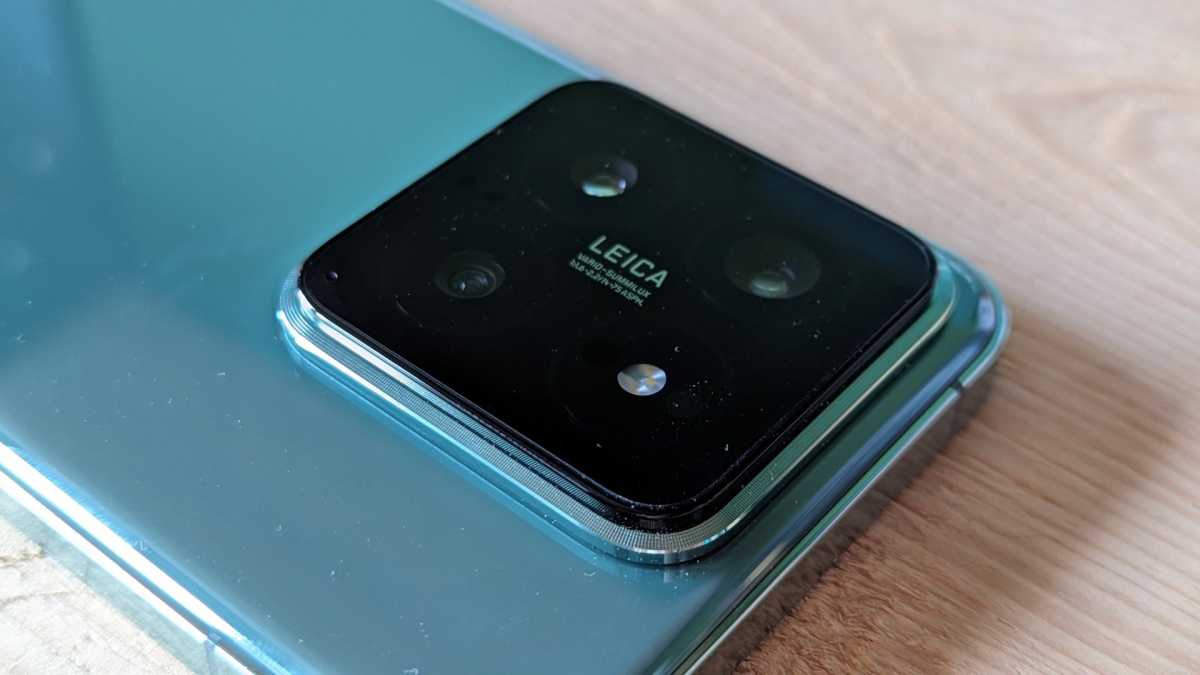
Chris Martin / Foundry
The combination of a 23mm (equivalent) f/1.6 main camera with a large 1/1.31-inch sensor, 14mm f/2.2 ultrawide and 75mm f/2.0 floating telephoto – all at high resolution – is incredible. It feels like you’re carrying around a compact DSLR with interchangeable lenses, just without having to physically swap them round.
Xiaomi offers absolutely stunning image quality on the 14, regardless of which camera you use. Thought it’s the main camera that I used the most, and it’s the one that really stands out. Results look nothing short of DSLR-level with eye-opening detail for starters.
Xiaomi offers absolutely stunning image quality on the 14, regardless of which camera you use
What I found particularly impressive is the way the Xiaomi 14 captures light. It’s actually tricky to put into words for some shots but there’s a really moody and intriguing quality to them – see the example below (albeit compressed for online viewing) where the light is coming in from the window and individual hairs are crisp.

Chris Martin / Foundry
The camera is quick to respond, able to focus and recognise faces with ease and almost always gets key settings like exposure and ISO right. The detail in shadows in astounding and I love the natural bokeh of the main lens, which makes portrait mode almost redundant.
It’s perhaps a little too shallow on occasion (check the hazy edge of the ice cream below) but this only happens rarely. Colour is true to life with the app set to the Leica Authentic mode, but you can quickly tap in the top corner to switch to a more saturated look with Leica Vibrant if you prefer.
As per the portrait mode, I also didn’t find I needed to manually select Night mode either, such is the low light performance of the phone. I think the results speak for themselves.
Moving to the telephoto lens (originally found on the Xiaomi 13 Pro) you can shoot an at optical zoom of 3.2x which is slightly more than the S24 and S24+ (both 3x). That aside, it’s the quality that’s the key thing here thanks to the combination of high resolution, OIS (optical image stabilisation) and fast f/2 aperture.
See for yourself in the samples below. You can zoom up to 60x in digital cropping but it’s no surprise that things start to get pixelated once you hit even half that figure.
The ultrawide is perhaps the least impressive of the three but it’s still far better than most on the market. It’s just that the other two cameras are so impressive, and I found them more useful in my photography than the ultrawide.
It doesn’t have OIS or as impressive an aperture, but quality is still very good and colour is close to the other cameras, too. The flexibility of a wider field of view will always be useful.
I found the cameras brilliant to work with without delving too far into the settings – congrats to Xiaomi for making the camera app so clean and user-friendly. But you can do things like shoot in RAW, at 50Mp resolution or with custom settings in Pro mode if you like.
Around the front is a 32Mp selfie camera with f/2 aperture. It’s in line with other flagship front-facing cameras, offering good detail and plenty of features – including a portrait mode with depth control and night mode.
You can also make use of ‘dynamic framing’ (aka cropping) to choose between 0.8x and 1.0x depending on how much you’re trying to fit into the shot. However, unlike some phones, it doesn’t automatically move between them.
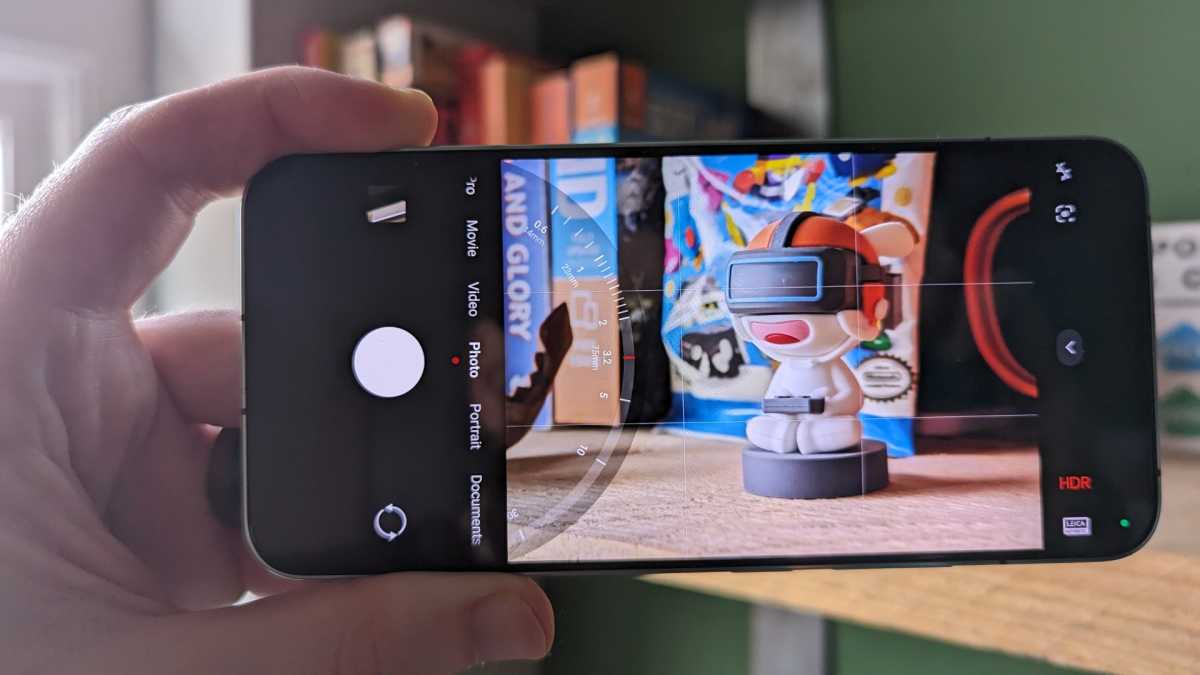
Chris Martin / Foundry
Moving onto video and the Xiaomi 14 continues to impress with the ability to shoot in up to 8K/24fps, but most will want to knock it down to 4K to get 30- or 60fps and Dolby Vision HDR.
I found video footage to be high quality, smooth, detailed and colourful. Audio quality is also above average, thanks to an array of four microphones.
My on gripe here is that although the app offers you a nice zoom wheel which smoothly zooms in and out like you’ve got an old school camcorder, it will switch between the rear cameras when you get to certain levels and the transition is often jarring.
Even so, I’m blown away by the cameras on the Xiaomi 14 and the Xiaomi 14 Ultra is even more impressive on paper, especially with the alluring Photography Kit, though it comes at a price.
And if you don’t want to take my word for it, the 14 is ranked third in its class by DXOMark at the time of writing, behind only the Pixel 8 and iPhone 15. Though it gets a lower score, those rivals don’t have a telephoto lens.
Battery Life & Charging
- 4610mAh
- 90W HyperCharge
- 50W wireless HyperCharge
A 4610mAh battery is a little below the oh so common 5000mAh capacity, but don’t worry too much.
I would personally rather take this and have the size and weight benefits that come with it, especially…

